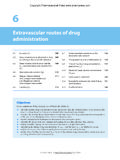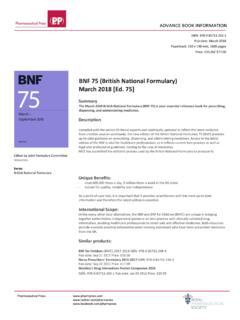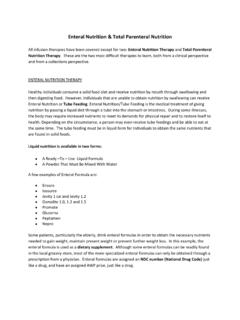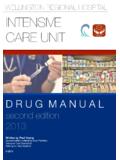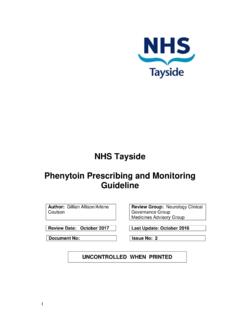Transcription of 6 Choice of medication formulation - …
1 6 Choice of medicationformulationRebecca WhiteKey PointslSolutions or soluble tablets are the formulations of not assume that liquid formulation will be not crush tablets or open capsules unless an alternative formulation or drug deciding which medication formulation is appropriate for administration via anenteral feeding tube, many factors need to be taken into consideration. It is not neces-sarily correct to assume that a liquid is preferable to a tablet; unwanted side-effects of theexcipients of a liquid formulation must be borne in mind.
2 The needs of the patient orcarers must also be considered; it may not be practical for the patient to carry severalbottles of liquid medication with them on a daily this chapter each of the formulations available will be reviewed. Guidance on howto administer the formulation will be given and advantages and disadvantages listed. Seechapter 9 for further information on appropriate Choice of formulationsSolutionsA solution is a homogenous one-phase system consisting of two or more solute is dispersed in the solvent. The solvent is usually present in the greateramount.
3 Syrup is a notable exception with w/w sucrose as the solute in of water as the :30/7/2010 AtTime:18:59:32pg: 1 Because a solution is a homogenous system, the drug will be distributed evenlythroughout the system. This is in contrast to a suspension, where inadequate mixingor settling may lead to variable is the most widely used solvent for pharmaceutical products. Some othersolvents can be used in combination with water to act as co-solvents and thereby increasethe solubility of the drug in the formulation . Examples of excipients used in solutions areethanol, sorbitol, glycerol and propylene glycol.
4 Inclusion of these excipients can deter-mine the suitability of a solution for administration via an enteral feeding tube; forexample, sorbitol can cause diarrhoea (see disadvantages below).Administration of solutions1. Stop the enteral Flush the enteral feeding tube with the recommended volume of water (see p. 11).3. Check the relevant monograph can the drug be administered with feed, or should aspecific time interval be allowed before administering the drug ?4. Draw the drug solution into an appropriate size and type of Flush the drug dose down the enteral feeding Finally, flush the enteral feeding tube with the recommended volume of water (see ).
5 7. Re-start the feed, unless a specific time interval is needed following the administra-tion of the , at step (4) measure the drug solution in a suitable container and then drawinto an appropriate size and type of syringe. Avoid syringes that are compatible withparenteral devices. Ensure that the measure is rinsed and that this rinsing water is admin-istered via the enteral feeding tube to ensure the total dose is notmeasure liquidmedicines using a catheter-tipped syringe, as this results in excessive dosing owing to thevolume of the drug distribution in the formulation allows accurate to for administration via an enteral feeding tube without further may be present in sufficient quantities to have a pharmacological effect,especially if present in all drug formulations being used.
6 For example, sorbitol ( 15 gday) will have a laxative not be considered practical for carrying and a short shelf-life may be :30/7/2010 AtTime:18:59:32pg: 22 Handbook of drug Administration via Enteral Feeding TubesSuspensionsA suspension formulation is usually developed when the drug is insoluble or if, forreasons of palatability, the drug is formulated into coated suspensions can be administered via enteral feeding tubes but mayrequire further dilution owing to the viscosity and granular suspensions, granule size and the viscosity of the formulation must betaken into account when assessing the suitability of the formulation for administrationvia an enteral feeding tube.
7 Examples of granular suspensions are ciprofloxacin, clari-thromycin and lansoprazole. Some granular suspensions contain enteric coated granules( Zoton suspension) or modified-release granules ( MST-continus suspension);caution should be exercised with such formulations to avoid changing the absorptioncharacteristics (see individual monographs).Administration of a suspension (see notes above)1. Stop the enteral Flush the enteral feeding tube with the recommended volume of water (see p. 11).3. Check the relevant monograph can the drug be administered with feed, or should aspecific time interval be allowed before administering the drug ?
8 4. Shake the medication bottle thoroughly to ensure adequate Draw the medication suspension into the appropriate size and type of Flush the medication dose down the enteral feeding Finally, flush the enteral feeding tube with the recommended volume of water (see ).8. Re-start the feed, unless a specific time interval is needed following the admini-stration of the , at step (5) measure the drug suspension in a suitable container and thenadd an equal volume of water and mix thoroughly. Draw this into an appropriate size andtype of syringe.
9 Avoid syringes that are compatible with parenteral devices. Ensure thatthe measure is rinsed and that this rinsing water is administered via the enteral feedingtube to ensure that the total dose is notmeasure liquid medicines using acatheter tipped syringe as this results in excessive dosing owing to the volume of the to use (few exceptions).lEasy to in suspension may be too large or the suspension may be too viscous to passthrough the enteral feeding or inadequate shaking may affect the accuracy of not be practical to carry :30/7/2010 AtTime:18:59:32pg: 3 Choice of medication formulation3lStability and shelf-life may be impracticalSolid dosage formulationsSoluble tabletsA soluble tablet dissolves completely when placed in water to give a solution of the drug ;this is usually achieved by using an alternative salt form, prednisolone of soluble tablets1.
10 Stop the enteral Flush the enteral feeding tube with the recommended volume of water (see p. 11).3. Check the relevant monograph can the drug be administered with feed, or should aspecific time interval be allowed before administering the drug ?4. Select an appropriate size and type of syringe for Remove the plunger and place the tablet into the barrel of the Replace the Draw 10mL of water into syringe and allow the tablet to dissolve, shaking Inspect the solution to ensure that there are no visible Flush the medication dose down the enteral feeding Draw an equal volume of water into the syringe and also flush this via the enteralfeeding tube (this will rinse the syringe and ensure that the total dose isadministered).
